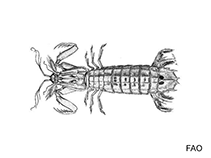Squilla cadenati Manning, 1970
Angolan mantis shrimpWarning: DOMDocument::load(): SSL operation failed with code 1. OpenSSL Error messages: error:140770FC:SSL routines:SSL23_GET_SERVER_HELLO:unknown protocol in C:\Apache24\htdocs\includes\SpeciesSummary.lib.php on line 1236
Warning: DOMDocument::load(): Failed to enable crypto in C:\Apache24\htdocs\includes\SpeciesSummary.lib.php on line 1236
Warning: DOMDocument::load(https://sealifebase.nrm.se/webservice/AquaMaps/getAMap.php?genus=Squilla&species=cadenati): failed to open stream: operation failed in C:\Apache24\htdocs\includes\SpeciesSummary.lib.php on line 1236
Warning: DOMDocument::load(): I/O warning : failed to load external entity "https://sealifebase.nrm.se/webservice/AquaMaps/getAMap.php?genus=Squilla&species=cadenati" in C:\Apache24\htdocs\includes\SpeciesSummary.lib.php on line 1236
Hochladen Photos
Google Bild | No image available for this species;
drawing shows typical species in Squillidae.
Google Bild | No image available for this species;
drawing shows typical species in Squillidae.
Classification / Names Common names | Synonyms | CoL | ITIS | WoRMS
| Stomatopoda | Squillidae
Environment: milieu / climate zone / depth range / distribution range Ökologie
; tiefenbereich 37 - 300 m (Ref. 436). Tropical
Verbreitung Länder | FAO Gebiete | Ecosystems | Vorkommen | Einführungen
Eastern Atlantic: Off West Africa, from Senegal to Angola.
Length at first maturity / Size / Gewicht / Alter
Maturity: Lm ? range ? - ? cm Max length : 17.0 cm BL Männchen/unbestimmt; (Ref. 417); common length : 15.0 cm BL Männchen/unbestimmt; (Ref. 436)
Kurzbeschreibung Morphologie
A moderately sized stomatopod. Body with conspicuous longitudinal ridges: sub median ridges of fifth abdominal segment with posterior spines; tail segment with a distinct median ridge. Claws large, armed with 6 spines on the terminal segment. Color: telson with a pair of dark triangle anteriorly, bright red in life (Ref. 436).
Found at depths of 37 to 300 m (Ref. 436).
Life cycle and mating behavior Geschlechtsreife | Fortpflanzung | Ablaichen | Eier | Fecundity | Larven
Some members of the order Stomatopoda pair for life and some come together only to mate. Males produce sperm ducts rather than spermatophores; females can brood a maximum of 50,000 eggs. Life cycle: Eggs hatch to a planktonic zoea which lasts for 3 months.
Hauptreferenz
Referenzen | Koordinator | Partner
Schneider, W. 1990. (Ref. 417)
IUCN Rote Liste Status (Ref. 130435)
CITES Status (Ref. 108899)
Not Evaluated
CMS (Ref. 116361)
Not Evaluated
Bedrohung für Menschen
Harmless
Nutzung durch Menschen
| FishSource |
Tools
Mehr Information
Internet Quellen
BHL | BOLD Systems | CISTI | DiscoverLife | FAO(Publication : search) | Fishipedia | GenBank (Genom, nucleotide) | GloBI | Gomexsi | Google Books | Google Scholar | Google | PubMed | Tree of Life | Wikipedia (Gehe zu, Suchen) | Zoological Record
Estimates based on models
Preferred temperature
(Ref. 115969): 14.2 - 17.8, mean 16.3 (based on 35 cells).
Preiskategorie
(Ref. 80766):
Unknown.



